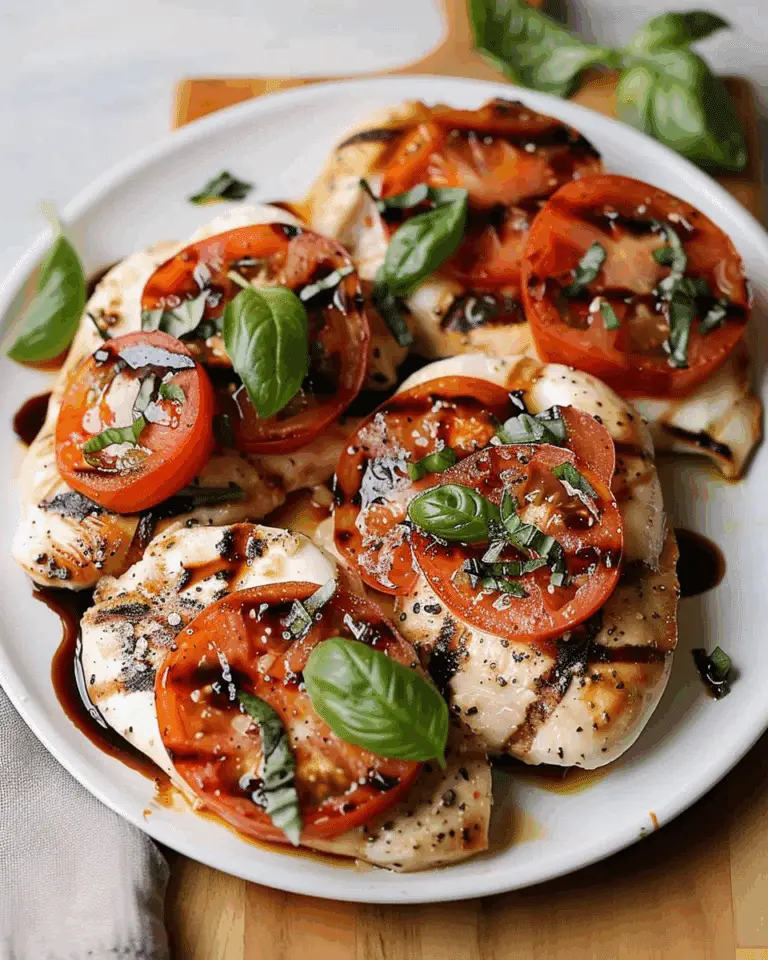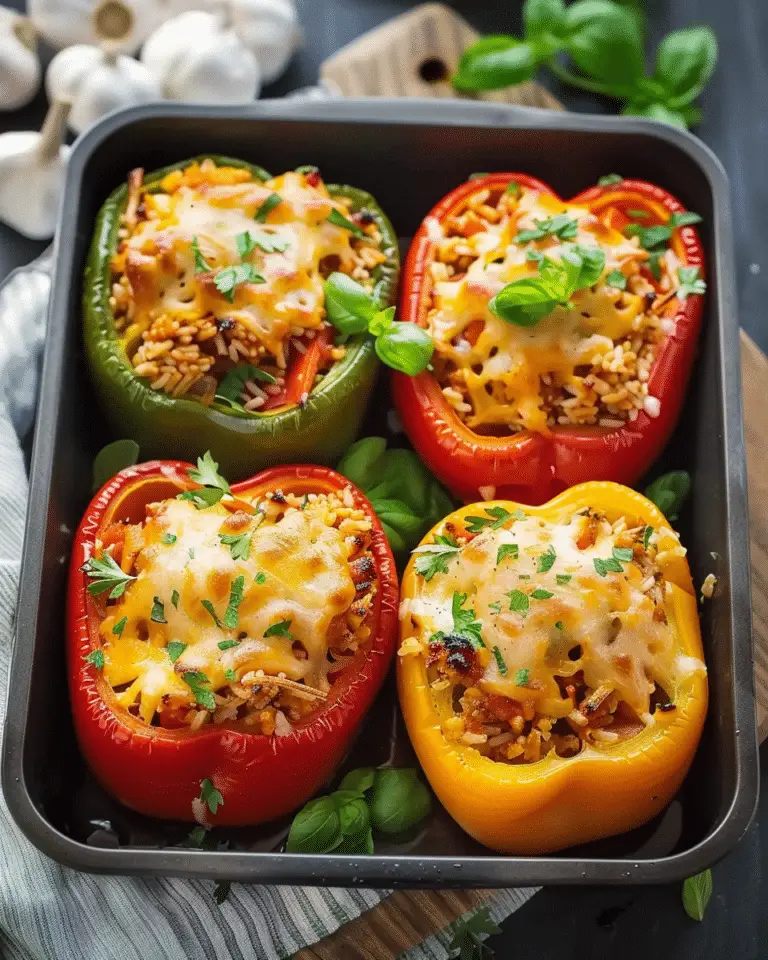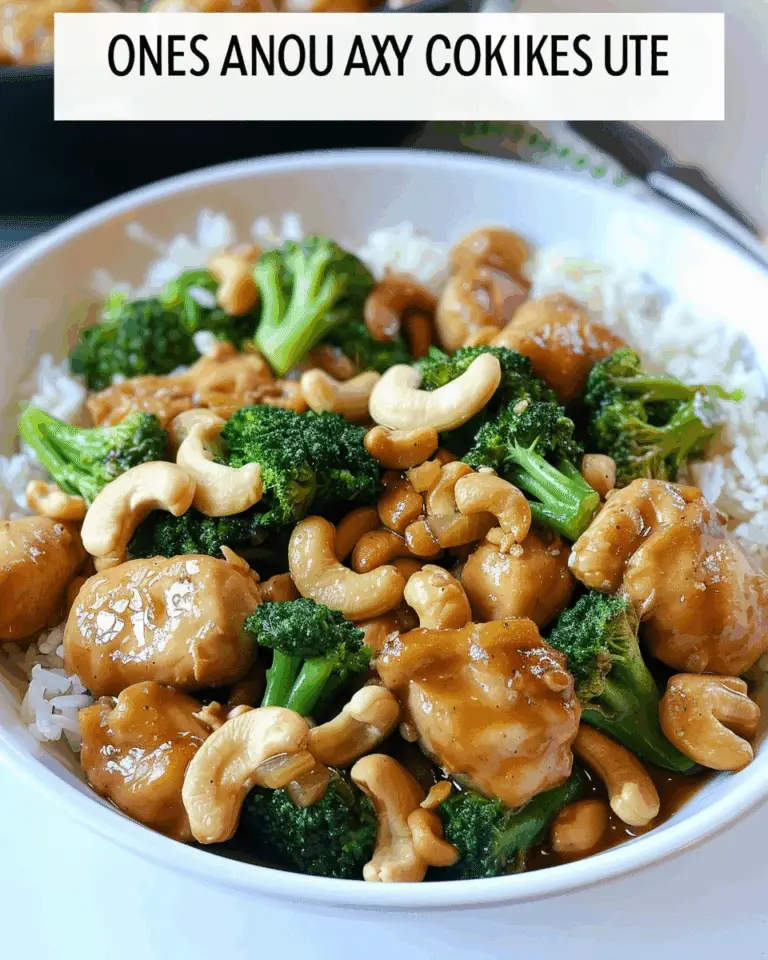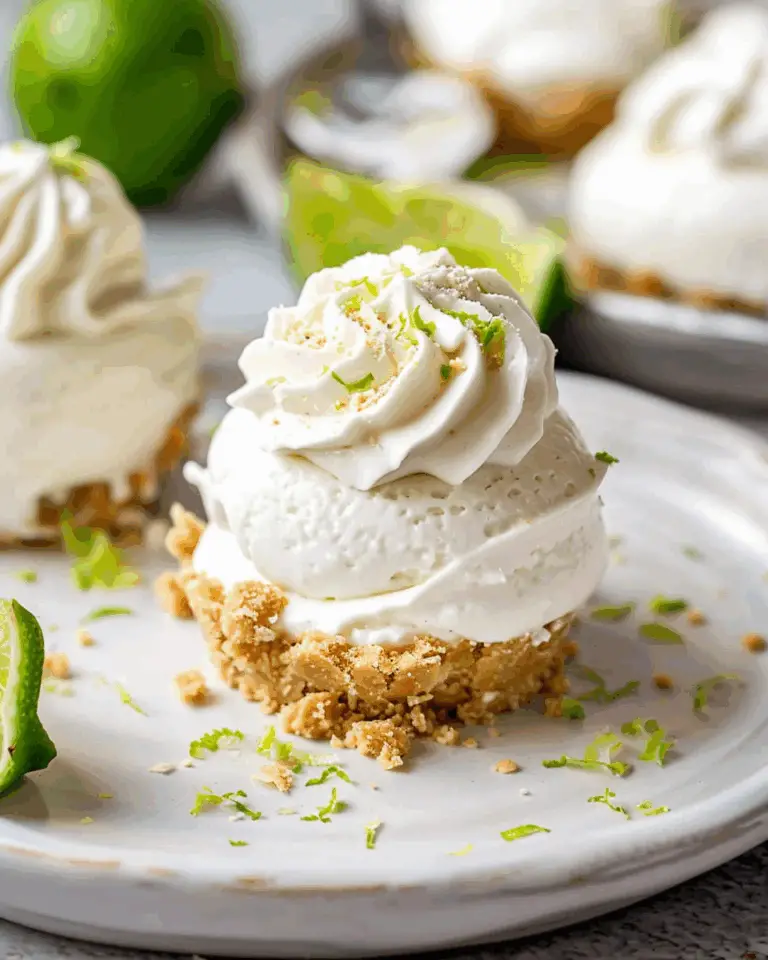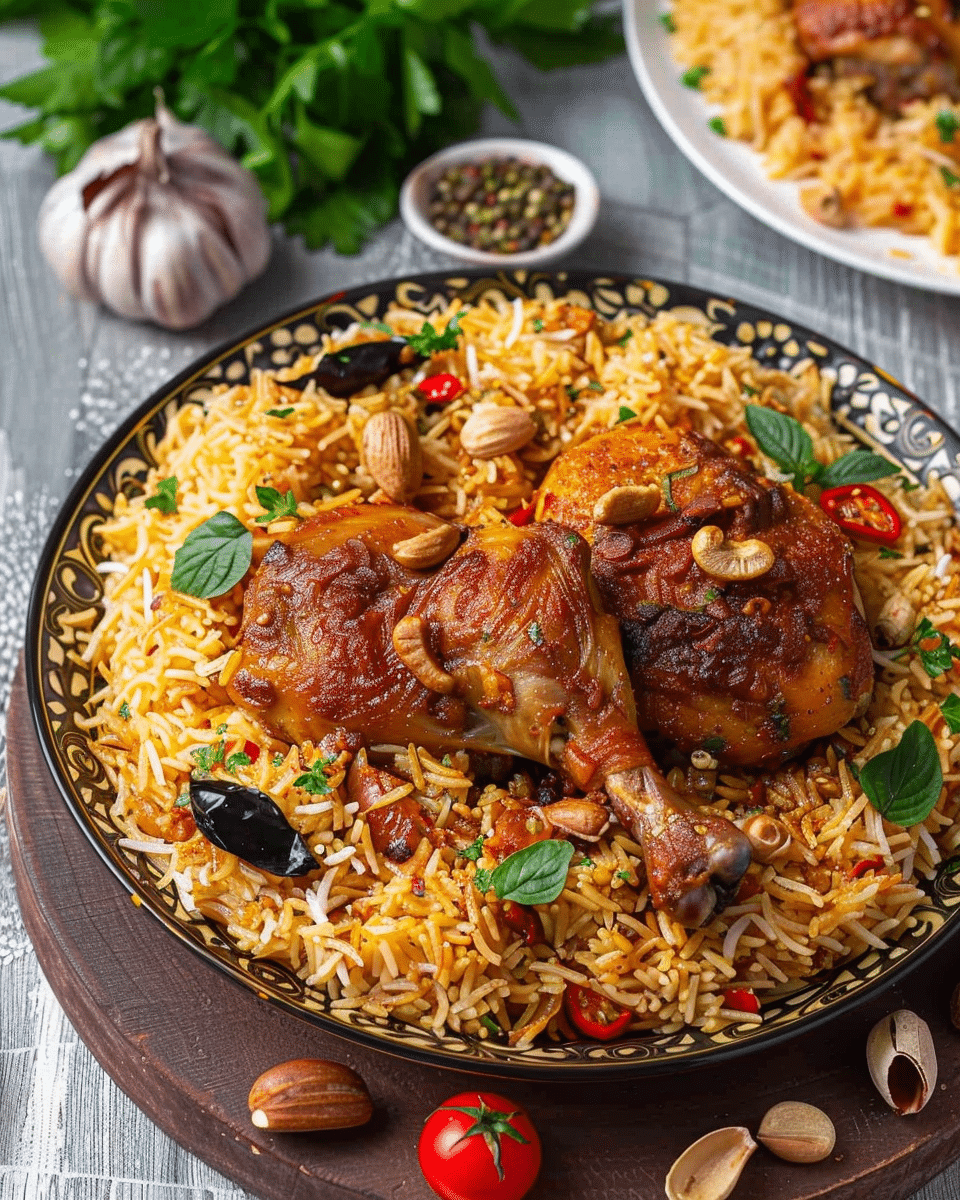
Why You’ll Love This Recipe
Kabsa is more than just a rice dish—it’s a celebration of flavor. The combination of tender meat, aromatic rice, and a perfectly balanced spice mix creates a meal that’s both comforting and rich. The spices in Kabsa, including turmeric, cumin, and coriander, offer a wonderful depth of flavor without overpowering the dish. Whether you prefer chicken, beef, or lamb, Kabsa is versatile and can be made with your choice of protein. It’s a complete meal in itself, but it also pairs wonderfully with a simple side salad or yogurt for an extra refreshing contrast.
Ingredients
For the Kabsa:
-
1 whole chicken (about 3-4 lbs), cut into pieces (or use beef or lamb)
-
2 cups basmati rice, rinsed
-
4 cups chicken broth (or water)
-
2 medium onions, finely chopped
-
4 cloves garlic, minced
-
2 medium tomatoes, chopped
-
2 tablespoons tomato paste
-
1/4 cup vegetable oil or ghee
-
1 cinnamon stick
-
3-4 cardamom pods, crushed
-
3-4 cloves
-
1 teaspoon cumin powder
-
1 teaspoon coriander powder
-
1 teaspoon turmeric powder
-
1 teaspoon paprika
-
1 teaspoon ground cinnamon
-
1/2 teaspoon black pepper
-
Salt to taste
For garnish:
-
Fresh cilantro, chopped
-
Fried onions (optional)
-
Lemon wedges (optional)
(Tip: You’ll find the full list of ingredients and measurements in the recipe card below.)
Directions
-
Prepare the chicken:
In a large pot, heat the vegetable oil or ghee over medium heat. Add the chicken pieces and sear them on all sides until they are golden brown. Once browned, remove the chicken from the pot and set it aside. -
Cook the base:
In the same pot, add the chopped onions and sauté them until they become soft and golden brown, about 5 minutes. Add the minced garlic and cook for another 1-2 minutes until fragrant. -
Add the spices:
Add the cinnamon stick, cardamom pods, cloves, cumin, coriander, turmeric, paprika, cinnamon, black pepper, and salt to the pot. Stir the spices for about 1 minute to toast them and release their aromatic oils. -
Cook the tomatoes:
Add the chopped tomatoes and tomato paste to the pot. Stir everything together and cook for about 5 minutes, allowing the tomatoes to soften and release their juices. -
Simmer the chicken:
Return the chicken pieces to the pot, then pour in the chicken broth (or water). Bring the mixture to a boil, then lower the heat and let it simmer for 30-40 minutes, or until the chicken is fully cooked and tender. -
Cook the rice:
While the chicken is simmering, rinse the basmati rice under cold water until the water runs clear. Once the chicken is cooked, remove it from the pot and set it aside. Add the rinsed rice to the pot with the broth and spices. Stir everything together and bring it to a boil. Reduce the heat to low, cover the pot, and let the rice cook for about 20 minutes, or until the rice is tender and all the liquid has been absorbed. -
Assemble the dish:
Once the rice is cooked, fluff it with a fork and return the chicken pieces on top of the rice. Cover the pot and let it sit for another 10 minutes to allow the flavors to meld together. -
Serve:
Garnish with fresh cilantro, fried onions (if using), and lemon wedges. Serve the Kabsa hot, and enjoy with a side of yogurt or a simple salad.
Servings and Timing
Servings: 4-6
Total time: 1 hour 30 minutes
Variations
-
Lamb Kabsa: You can use lamb instead of chicken for a richer, more flavorful Kabsa. Just adjust the cooking time as needed to ensure the lamb is tender.
-
Beef Kabsa: Beef also works well in Kabsa. You can use beef stew cubes or a beef roast, cut into pieces. The cooking time may need to be adjusted depending on the cut of beef you use.
-
Vegetarian Kabsa: Skip the meat entirely and use a variety of vegetables like carrots, bell peppers, and peas. You can also add nuts, such as almonds or raisins, for extra texture and flavor.
-
Spicy Kabsa: If you prefer more heat, add some chopped fresh chili peppers or increase the amount of paprika and black pepper.
Storage/Reheating
Storage: Kabsa can be stored in an airtight container in the refrigerator for up to 3-4 days. The flavor tends to improve as it sits, making it great for leftovers.
Reheating: Reheat Kabsa on the stovetop over medium-low heat, adding a splash of water or broth to prevent it from drying out. You can also microwave individual servings.
FAQs
1. Can I use other types of rice for Kabsa?
Basmati rice is ideal for Kabsa due to its fragrance and long grains, but you can substitute with other long-grain rice if needed. Just be sure to adjust the cooking time.
2. How do I make Kabsa spicier?
To make Kabsa spicier, you can add chopped fresh chilies, more paprika, or even a pinch of cayenne pepper. Adjust the spice level to your preference.
3. Can I make Kabsa without ghee or oil?
Yes, you can use olive oil or any other cooking oil of your choice instead of ghee. Ghee adds a rich flavor, but olive oil will work just as well.
4. Can I make Kabsa ahead of time?
Yes, Kabsa can be made ahead of time and stored in the refrigerator for up to 3-4 days. The flavors tend to develop further after a day or two.
5. What meat can I use in Kabsa?
Kabsa is commonly made with chicken, lamb, or beef, but you can also use fish or shrimp for a seafood variation. The cooking time will vary depending on the type of meat you choose.
6. How can I make Kabsa vegetarian?
Simply omit the meat and use a variety of vegetables, such as carrots, bell peppers, peas, and cauliflower. You can also add dried fruits, like raisins, and nuts for added texture.
7. How do I prevent the rice from being too dry?
If the rice becomes dry, add a bit more liquid during cooking or place a damp towel over the pot before covering it with a lid. This will trap moisture and prevent the rice from drying out.
8. Can I freeze Kabsa?
Yes, you can freeze Kabsa for up to 2-3 months. Let it cool completely before transferring it to an airtight container or freezer bag. Thaw in the refrigerator overnight before reheating.
9. What should I serve with Kabsa?
Kabsa is often served with a side of yogurt, salad, or pickled vegetables. You can also serve it with flatbreads, such as pita or naan.
10. How can I make Kabsa more flavorful?
For deeper flavor, you can add a piece of smoked meat during the cooking process or cook the rice in a mixture of broth and a bit of saffron.
Conclusion
Kabsa is a flavorful and satisfying dish that brings the spices and aromas of the Middle East to your table. The combination of tender meat, fragrant rice, and the perfect balance of spices makes it a comforting meal for any occasion. Whether you’re cooking for a family dinner or a special celebration, Kabsa is a dish that will leave everyone impressed and asking for seconds. Enjoy it with a refreshing side of yogurt or a light salad to balance the rich flavors of this iconic dish.

Kabsa
5 Stars 4 Stars 3 Stars 2 Stars 1 Star
No reviews
- Author: Ava
- Total Time: 1 hour 30 minutes
- Yield: 4-6 servings
Description
Kabsa is a flavorful Middle Eastern rice dish, particularly popular in Saudi Arabia and other Gulf countries. It combines fragrant rice with tender meat, such as chicken, lamb, or beef, and is cooked with a blend of spices like cinnamon, cardamom, and cumin.
Ingredients
- 1 whole chicken (about 3-4 lbs), cut into pieces (or use beef or lamb)
2 cups basmati rice, rinsed
4 cups chicken broth (or water)
2 medium onions, finely chopped
4 cloves garlic, minced
2 medium tomatoes, chopped
2 tablespoons tomato paste
1/4 cup vegetable oil or ghee
1 cinnamon stick
3-4 cardamom pods, crushed
3-4 cloves
1 teaspoon cumin powder
1 teaspoon coriander powder
1 teaspoon turmeric powder
1 teaspoon paprika
1 teaspoon ground cinnamon
1/2 teaspoon black pepper
Salt to taste
For garnish: Fresh cilantro, chopped; Fried onions (optional); Lemon wedges (optional)
Instructions
Prepare the chicken: In a large pot, heat the vegetable oil or ghee over medium heat. Add the chicken pieces and sear them on all sides until they are golden brown. Once browned, remove the chicken from the pot and set it aside.
- Cook the base: In the same pot, add the chopped onions and sauté them until they become soft and golden, about 5 minutes. Add the minced garlic and cook for another 1-2 minutes until fragrant.
- Add the spices: Add the cinnamon stick, cardamom pods, cloves, cumin, coriander, turmeric, paprika, cinnamon, black pepper, and salt. Stir the spices for about 1 minute to toast them and release their aromatic oils.
- Cook the tomatoes: Add the chopped tomatoes and tomato paste to the pot. Stir everything together and cook for about 5 minutes, allowing the tomatoes to soften and release their juices.
- Simmer the chicken: Return the chicken pieces to the pot, then pour in the chicken broth (or water). Bring the mixture to a boil, then lower the heat and let it simmer for 30-40 minutes, or until the chicken is fully cooked and tender.
- Cook the rice: While the chicken is simmering, rinse the basmati rice under cold water until the water runs clear. Once the chicken is cooked, remove it from the pot and set it aside. Add the rinsed rice to the pot with the broth and spices. Stir everything together and bring it to a boil. Reduce the heat to low, cover the pot, and let the rice cook for about 20 minutes, or until the rice is tender and all the liquid has been absorbed.
- Assemble the dish: Once the rice is cooked, fluff it with a fork and return the chicken pieces on top of the rice. Cover the pot and let it sit for another 10 minutes to allow the flavors to meld together.
- Serve: Garnish with fresh cilantro, fried onions (if using), and lemon wedges. Serve the Kabsa hot, and enjoy with a side of yogurt or a simple salad.
Notes
- Lamb Kabsa: You can substitute chicken with lamb for a richer, more flavorful Kabsa. Adjust the cooking time for the lamb to ensure it’s tender.
- Beef Kabsa: Beef works well in Kabsa. Use beef stew cubes or a beef roast, cut into pieces, and adjust the cooking time as needed.
- Vegetarian Kabsa: Skip the meat entirely and use vegetables like carrots, bell peppers, and peas. Add nuts like almonds or raisins for extra texture.
- Spicy Kabsa: Add fresh chili peppers or more paprika to make the dish spicier.
- Prep Time: 10 minutes
- Cook Time: 1 hour 15 minutes
- Category: Main Dish, Middle Eastern Cuisine
- Method: Sautéing, Simmering
- Cuisine: Middle Eastern
Nutrition
- Serving Size: 1 serving
- Calories: 550
- Sugar: 3g
- Sodium: 600mg
- Fat: 22g
- Saturated Fat: 5g
- Unsaturated Fat: 15g
- Trans Fat: 0g
- Carbohydrates: 60g
- Fiber: 2g
- Protein: 30g
- Cholesterol: 90mg


